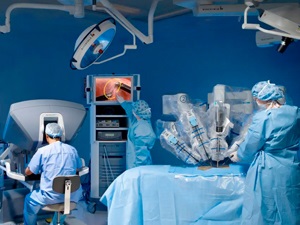Robotic-assisted General Surgery
 Yavapai Regional’s new Da Vinci Xi robot assists in orthopedic,
urologic, gynecologic, and general-surgery procedures. Our first cases
occurred on January 12, 2024.
Yavapai Regional’s new Da Vinci Xi robot assists in orthopedic,
urologic, gynecologic, and general-surgery procedures. Our first cases
occurred on January 12, 2024.
The robotic system is led by the surgeon, whose hand movements are
translated into precise micro-movements of the surgical instruments. The
movements replicate the human hand but with a greater range of motion.
Complex procedures, which in the past only could be accomplished through
more invasive approaches and larger openings, now can be performed through
tiny incisions.
The surgeon conducts the procedure through a console in the operating room.
A high-magnification endoscopic camera delivers high-definition, magnified
3D views with brilliant color and natural depth of field. Motion scaling
and tremor reduction further refine the surgeon’s hand movements.
The benefits are clear. Patients who receive robotic-assisted surgery
typically experience less pain, shorter recovery times, shorter hospital
stays, less blood loss and scarring, less post-operative pain medications,
and a lower risk of infection. Robotic surgery isn’t an option for
everyone. Because every person is different, the surgical team at Yavapai
Regional works closely with each patient to determine the best procedure
for their specific condition and overall health.
State-of-the-Art Neurosurgery
Neuro and spinal surgeries are among the most complex and high-stake procedures in medicine. They require
both an exceptionally skilled neurosurgical team and trailblazing technology. This and more meet at Dignity
Health Yavapai Regional Medical Center, where minimally invasive intracranial (skull) and neurosurgery of the
spine are performed using Medtronic’s O-arm™ Surgical Imaging System and StealthStation™ Navigation. In
the hands of our outstanding neurosurgical team, these powerful technologies are getting people back to their
lives faster.
The O-arm merges the technology of a CT scan with virtual navigation. This provides the Dignity Health
Yavapai Regional neurosurgical team with three-dimensional, high-quality, and real-time images of the skull or
spine during procedures. The Yavapai Regional team combines the O-arm technology with the
StealthStation—which operates like a powerful GPS—to navigate difficult-to-visualize anatomy and repair the
patient’s spine or skull.
Additionally, during spine surgery, the neurosurgical team accesses the patient’s spine through the soft tissues
of the side, rather than the abdominal cavity or the back. This makes recovery easier for the patient and keeps
the surgical incision small.
Patients benefit from this minimally invasive surgery in other ways, including:
- Less time in surgery
- Fewer and smaller incisions than traditional surgery
- More precise placement of implants for better results
- Preserves healthy tissue during surgery
- Less pain than with conventional surgery
- Fewer complications
- Shorter recovery time
Who is eligible for minimally invasive neuro and spinal surgery? Every person is different, which is why
Yavapai Regional's neurosurgery team works closely with each patient to determine the best procedure for
their condition and overall health.